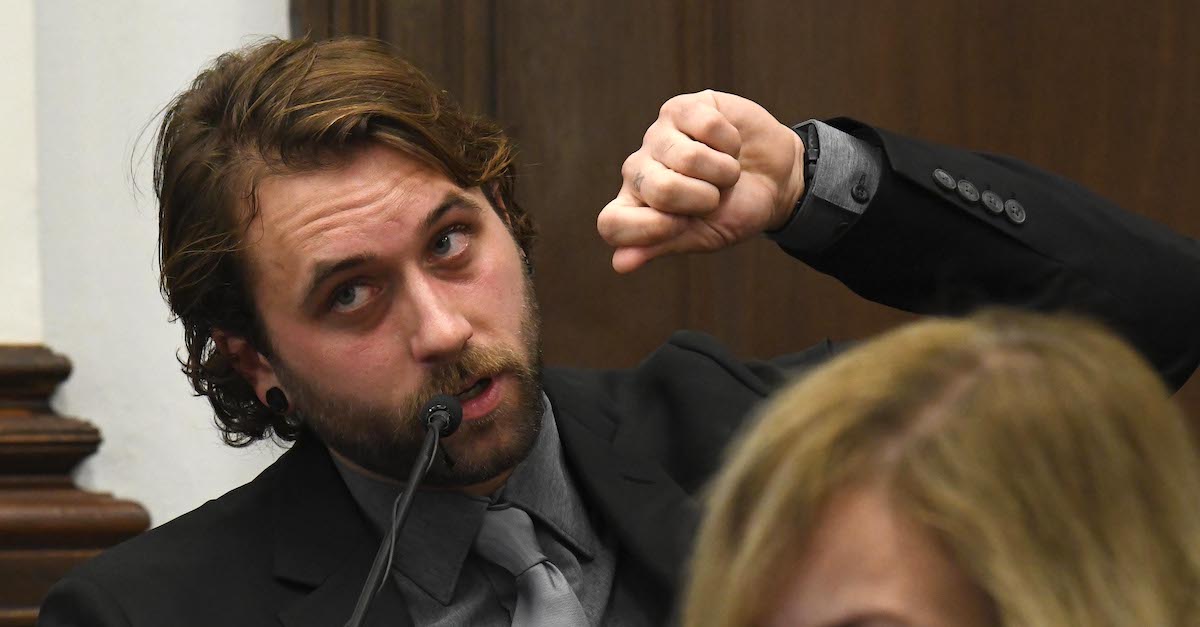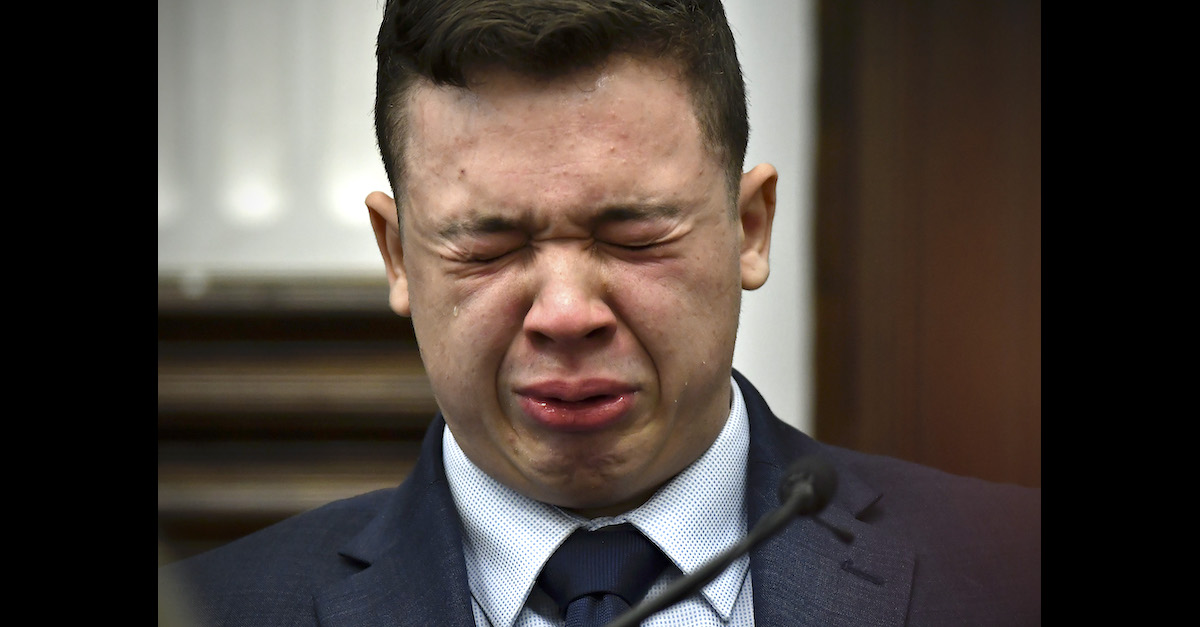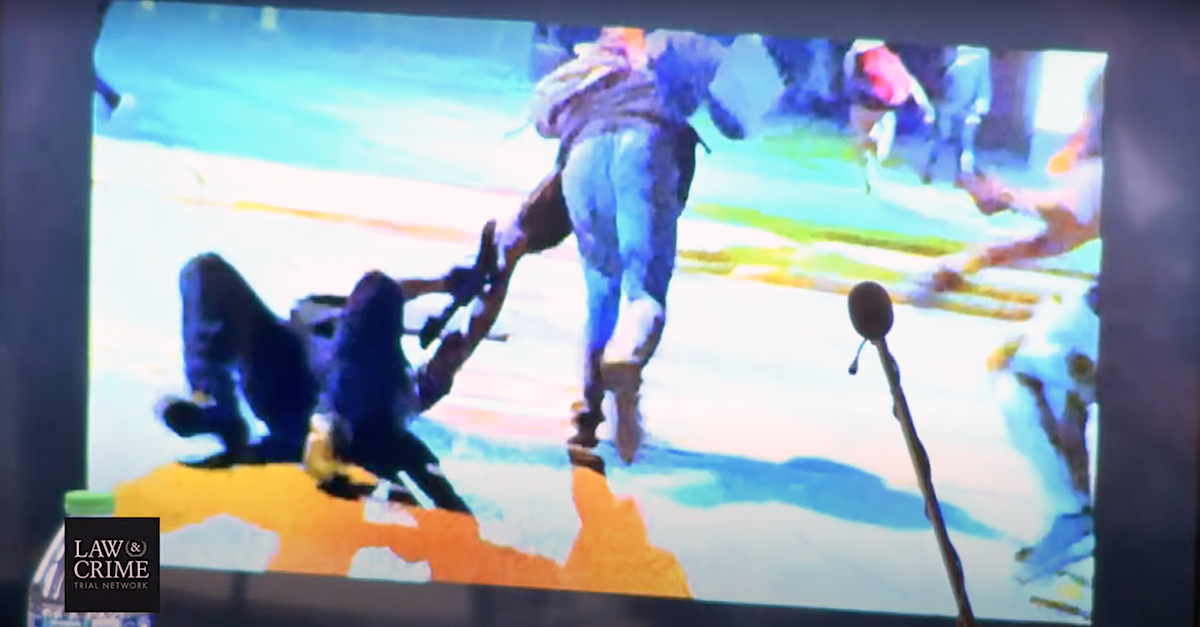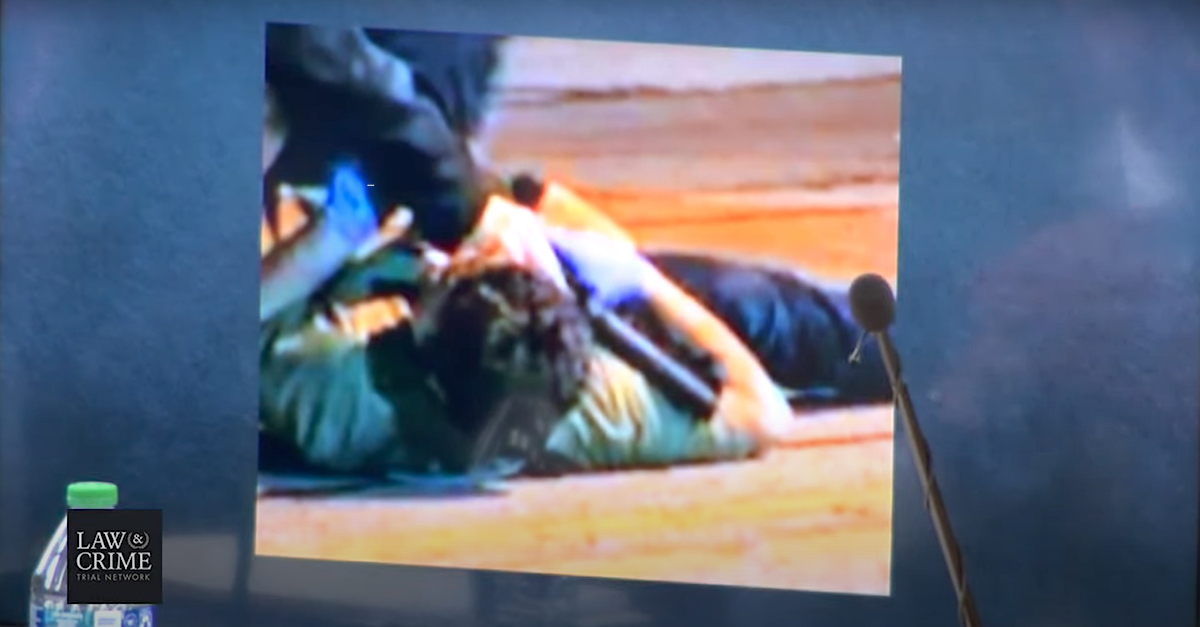
Gaige Grosskreutz testifies on November 8, 2021, in Kyle Rittenhouse’s murder trial. Here, he explains as a paramedic how to properly irrigate the eye of a person who has been pepper sprayed. (Pool image © Mark Hertzberg/ZUMA Press Wire.)
Gaige Grosskreutz, the Wisconsin man who was shot in the arm by Kyle Rittenhouse on Aug. 25, 2020, wants to change his legal name. That’s according to the Milwaukee Journal-Sentinel, which cited “a conservative news outlet” as the original source of the information.
Grosskreutz’s petition, the Journal-Sentinel said, was supposed to have been “secret,” and its leak reportedly led Grosskreutz’s attorney to call for a probe into how the matter became public. However, the petition is indeed referenced on the public court docket under Grosskreutz’s name as Kenosha County case number 2022CV6150. It is listed only as a “confidential name change.” The actual records contained in the docket are fully sealed; only the docket entry is public.
The “conservative news outlet” in question, the Kenosha County Eye, is reportedly operated by Kevin Mathewson, the former Kenosha alderman who the Journal-Sentinel said had asked armed volunteers to defend the city during a period of civil unrest.
“Mathewson then covered the Rittenhouse trial as a freelance photographer and got into a public yelling match with one of the prosecutors at one point,” the Journal-Sentinel noted.
Grosskreutz, now 29, of West Allis, Wisconsin, was shot on Sheridan Road in Kenosha after Rittenhouse killed two other men with an AR-15-style rifle. The shootings occurred after several nights of what the Journal Sentinel called “protests, looting and arson” over the police shooting of Jacob Blake Jr.

Kyle Rittenhouse broke down on the stand as he testified about his encounter with the late Joseph Rosenbaum. (Photo by Sean Krajacic-Pool/Getty Images.)
Grosskreutz’s attorney, Kimberly Motley, told the Milwaukee newspaper that she believed someone in the clerk of court’s office leaked the petition for a name change to Mathewson’s news outlet and demanded to know who had access to the file. The newspaper indicated that the court clerk was looking into that complaint.
Grosskreutz reportedly released the following statement through Motley to the Journal-Sentinel:
Yes, after two years of death threats from right wing lunatics I made the difficult decision to change my name for the protection of me and my family.
But the real story here isn’t that I am seeking to change my name, but that a process that is supposed to protect and shield those in danger was undermined and sealed information was released to the right wing media within hours of my filing.
I was told that my filing was confidential. I demand that the court investigate how this was leaked to ensure that those seeking protection in the future receive the protection to which they are entitled. On Tuesday, I was denied that protection.
Motley did not immediately respond to a Law&Crime email or telephone call for a copy of the statement and any additional comments on the trajectory of the requested probe.
The Kenosha County District Attorney’s Office charged Rittenhouse with intentional homicide, attempted intentional homicide, reckless homicide, and two counts of recklessly endangering safety — all with the alleged use of a dangerous weapon. A jury acquitted Rittenhouse of all of those charges. Two other counts, the possession of a dangerous weapon by a person under the age of 18 and failure to comply with an emergency curfew, were dismissed on a defense motion before deliberations began.
During the trial, prosecutor Thomas Binger told the jury that “life is more important than property” and suggested that Rittenhouse instigated the deaths of Joseph Rosenbaum, 36, and Anthony Huber, 26, by bringing a gun to the riots that had damaged both chattels and real estate in Kenosha.
“You cannot claim self-defense against a danger that you create,” Binger later asserted as to Rittenhouse.
The jury did not buy the state’s arguments. Instead, the jury credited defense assertions that Rittenhouse pulled the trigger only after others had first attacked him “in the street like an animal.”

Anthony Huber (standing) attempted to disarm Kyle Rittenhouse (on the ground) after Rittenhouse shot and killed Joseph Rosenbaum. (Image via the Law&Crime Network.)
The defense also said Rittenhouse only fired his weapon after receiving “flat out threats” from Rosenbaum, the first person he shot and killed. Those threats indicated that Rosenbaum predicted or wished to see that Rittenhouse would be murdered, the defense said at trial.
After Rosenbaum was fatally wounded, Huber held Rittenhouse to the ground; defense attorney Mark Richards said Rittenhouse at that point feared Huber would disarm him and use his own gun to kill him. Video images of the mayhem showed Huber with his hand on Rittenhouse’s gun and holding Rittenhouse to the ground.

Anthony Huber and Kyle Rittenhouse appear in an Aug. 25, 2020 image showed by defense attorneys during opening statements. Rittenhouse, in green, is on the ground. (Image via the Law&Crime Network.)
Grosskreutz said he was in Kenosha to act as a paramedic — though not in connection with his employment. He was eventually caught in the crossfire.
Grosskreutz testified that he pulled his own Glock handgun because he believed Rittenhouse was an active shooter.
Grosskreutz claimed did not intend to use his gun and that his hand was not positioned to shoot the weapon, but he also testified that Rittenhouse shot him when he admittedly — but, he claimed, unintentionally — pointed his Glock toward Rittenhouse.
Rittenhouse’s gun initially jammed. Then, Grosskreutz jumped on Rittenhouse.
Rittenhouse shot Grosskreutz in the right bicep during the mayhem.
Rittenhouse’s defense lawyers accused Grosskreutz of lying to authorities by omission: he failed to mention to investigators that he was armed with a Glock when he encountered Rittenhouse.